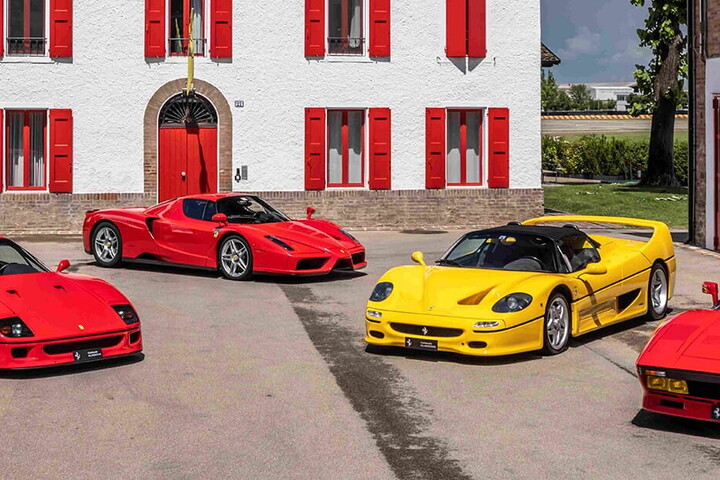The very name held the promise of a unique model on a cold night in Turin in 1970. Countach, an English neologism from the Piedmont dialect's word ‘contacc', which means ‘wow!, upon my word!'. The person who exclaimed it was never precisely identified, whether he was a security guard at the Bertone racing stables or a corporate profiler. The truth is, however, that Paolo Stanzani – Technical Director of Lamborghini - chose the name for the new car, thus breaking with the tradition of evoking famous breeds of bulls, such as Urraco, Espada, Murcielago, Aventador and Miura. A car that marked 20 years of automobile history in terms of style and technical features was born: the manifesto of Lamborghini's audacity.
Here you can find tyres for your classic cars, included Countach: https://www.pirelli.com/tyres/en-ww/car/collection

Stanzani and Gandini, brilliant minds
The chassis designed by Engineer Stanzani - a trellis of ultra fine tubes embracing the entire structure of the passenger compartment - was a genuine masterpiece. It featured the same remarkable standards of the body created without limitations by Marcello Gandini, a young designer employed by Bertone. The ultimate super sports car in the Bull's stables demolished all principles in the sector: if Miura, with its large engine transversally mounted at the rear, gave Enzo Ferrari reason to (partly) rethink the old rule according to which, “horses must always be positioned to draw the cart, and never to push it,” Countach moved way beyond this. It was a race car that seemed to have landed from another world. Indeed, it was a sharp wedge made up of flat surfaces and corners, which promised to surpass the record of 300 km/hour. Its formal language established a 'before' and an 'after' in the history of car design. Gandini's stroke of genius was the spectacular door opening system. The doors shifted upwards and forwards with an unprecedented scissor-like motion that instantly outdated systems installed on the most advanced race cars at the time.
A unique engine
Some minor but significant details were changed between its first stunning apparition at the Salone di Ginevra in 1971 and the final presentation at the same motor show in 1973: two large Naca air vents were created on the sides, as well as periscope-shaped ones installed above the rear wheel arch. The years 1974-1978 witnessed 151 Countach LP 400 vehicles leave the gates of the Sant'Agata Bolognese facility. The acronym indicates the layout and position of the 4-litre V12 engine (longitudinal installed at the rear). When all is said and done, it wins the comparison with the initially conceived powerful 5-litre engine that was outside the budget range of the Swiss group, which acquired the company in 1972. However, those were challenging years for Lamborghini. Countach's success did not suffice, and the car maker filed for bankruptcy in 1978. The new owners – the French Mimran brothers – took over in 1980. Their offer far exceeded Ferruccio Lamborghini's one. Besides, they had the winning idea of summoning Engineer Giulio Alfieri from Maserati to place him in charge of the renewal plan.

Business is relaunched in the 1980s
With Alfieri and his technicians, Countach experienced a significant evolution. In March 1982, the engine installed on the LP 500 S was finally enhanced to 4750 cc (with 375HP at 7000 rpm). The version with four valves per cylinder (5167 cc, 455HP at 7000 rpm) made its début three years later. The Four-Valve version was more reliable, easily exceeding 300 km/h, and it was far more stable than in the past. In a nutshell, it was the mature version of Countach. Improvements implemented on the vehicles by the Sant'Agata technicians had a remarkable impact on sales. Indeed, 321 LP 500 S were delivered in less than three years, 84 more than the LP 400s sold during the first four years of production. But the Mimran brother's adventure was drawing to a close in 1986-1987, when project LP 132 designed to replace Countach was launched. Lamborghini was sold to Chrysler International, a branch of the Detroit-based giant.

The Bull's 25th anniversary version
The expansion plan conceived by the Americans promised mind-boggling numbers and a long series of new models, but it finally and inevitably generated confusion in Lamborghini's Italian branch. Countach made its farewell parade, and the anxious wait for the new super car Diablo commenced. It was an opportunity for the car maker based in Bologna to highlight Countach Anniversary, a special version launched in 1988 to celebrate the Bull's first 25 years. Most of the stylistic innovations were inspired by Countach Evoluzione's 1986 prototype. It was the first supercar in the world to be made of carbon fibre. It was never mass produced also due to the high manufacturing costs of such a chassis. Horacio Pagani, the project's designer, later established Pagani Automobili, which partnered Lamborghini during those years. The coupé's astounding triumph with loyalised customers came as a surprise: 658 vehicles were sold in barely two years, making it the most successful version of a leading model on the market for 17 years. An exit worthy of a queen, after 30 years. But Countach was a queen from birth.




